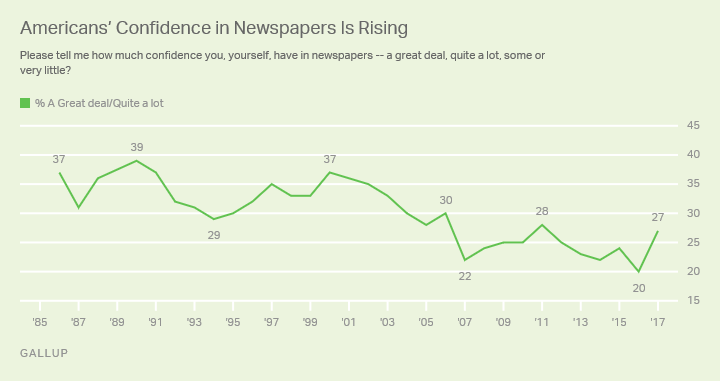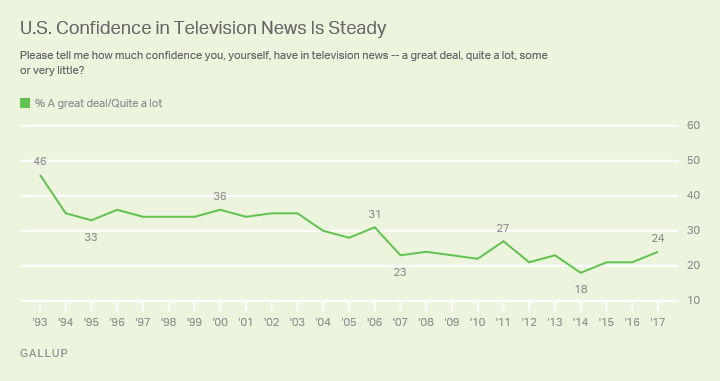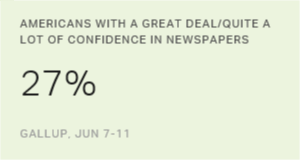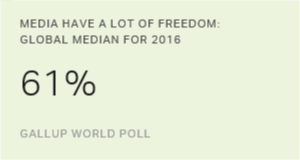Story Highlights
- 27% say they have "a great deal" or "quite a lot" of confidence in newspapers
- 24% have high confidence in television news
- 16% have high confidence in news on the internet
WASHINGTON, D.C. -- Despite an ongoing controversy over "fake news," more Americans this year (27%) say they have a "great deal" or "quite a lot" of confidence in newspapers than did so last year (20%). Although confidence in newspapers is up from last year's record low, it remains lower than it typically was in the 1980s and 1990s.

Newspapers are one of 16 institutions Gallup tested in a June 7-11 poll. The jump of seven percentage points from 2016 is the largest one for any institution -- though newspapers only tie for 11th overall on the list, based on Americans who have a great deal or quite a lot of confidence.
From a long-range perspective, confidence in newspapers hasn't been high at any point over the past 30 years; the highest was 39% in 1990. The 27% who express confidence this year is the highest recorded since 2011.
Democrats primarily are driving the overall increase in confidence in newspapers this year from last year's all-time low. In 2016, 28% of Democrats had "a great deal" or "quite a lot" of confidence in printed media, but that percentage rose to 46% this year. Sixteen percent of Republicans last year had confidence but, in contrast to Democrats, that has edged down to 13% this year.
These party differences may represent a backlash against President Donald Trump's proclamation that the media are "the enemy of the people." Newspapers -- traditionally viewed as the centerpiece of media -- may be holding a renewed attraction for Democrats in light of the president's comments. Also, with more partisan internet blogs and websites purporting to be news sites, Democrats may be showing a greater affinity for the traditional printed word.
Few Americans Confident in Television News
Americans are no more confident in television news than in newspapers. As the line between news and opinion is often blurred on cable networks, 24% of U.S. adults say they possess confidence in television news. Still, this is up from the record low of 18% in 2014 and is the highest since 2011.

This year's level of confidence in television news is almost half as high as it was the first time Gallup asked this question, in 1993 (46%). During the more than two decades that have followed, television news has been transformed from three broadcast networks and a handful of cable outlets to a proliferation of dozens of all-news and information channels across all of television broadcasting.
Americans Still Not Confident About News From the Internet
Although digital news sites have exploded with traffic, Americans have even less confidence in news that appears on the internet (16%) than they do in newspapers or television news. Gallup has asked about this kind of news only two times before: In 2014, it found that 19% had a great deal of confidence, and in 1999, 21% expressed the same sentiment.
| 1999 | 2014 | 2017 | |||||||||||||||||||||||||||||||||||||||||||||||||||||||||||||||||||||||||||||||||||||||||||||||||
|---|---|---|---|---|---|---|---|---|---|---|---|---|---|---|---|---|---|---|---|---|---|---|---|---|---|---|---|---|---|---|---|---|---|---|---|---|---|---|---|---|---|---|---|---|---|---|---|---|---|---|---|---|---|---|---|---|---|---|---|---|---|---|---|---|---|---|---|---|---|---|---|---|---|---|---|---|---|---|---|---|---|---|---|---|---|---|---|---|---|---|---|---|---|---|---|---|---|---|---|
| % | % | % | |||||||||||||||||||||||||||||||||||||||||||||||||||||||||||||||||||||||||||||||||||||||||||||||||
| A great deal/Quite a lot | 21 | 19 | 16 | ||||||||||||||||||||||||||||||||||||||||||||||||||||||||||||||||||||||||||||||||||||||||||||||||
| Gallup | |||||||||||||||||||||||||||||||||||||||||||||||||||||||||||||||||||||||||||||||||||||||||||||||||||
Bottom Line
Despite recent discussion about "fake news" and suspicions about the motivations of newspapers, as well as TV and internet news, Americans' confidence in these institutions has been soft for a long time. The general lack of confidence in the news media as an institution aligns with findings last fall that showed trust in the mass media at an all-time low. The low readings for these media institutions may be happening because of the sheer volume of media now. When there were only a few major national newspapers, a select number of local newspapers and even fewer television news channels, Americans may have found it easier to trust these institutions. Now, there is an abundance of internet news sites that attempt to increase traffic by appealing to only one side of the political spectrum or the other.
Yet a bright spot for the media may actually be in newspapers. If Trump continues his assault on the news media, it will be interesting to see whether the backlash Democrats may have initiated this year endures. Additionally, with "fake news" lingering, traditional newspapers may have an opportunity to position themselves as bastions of "good journalism," which may cause confidence to rise.
Historical data are available in Gallup Analytics.
Survey Methods
Results for this Gallup poll are based on telephone interviews conducted June 7-11, 2017, with a random sample of 1,009 adults, aged 18 and older, living in all 50 U.S. states and the District of Columbia. For results based on the total sample of national adults, the margin of sampling error is ±4 percentage points at the 95% confidence level. All reported margins of sampling error include computed design effects for weighting.
Each sample of national adults includes a minimum quota of 70% cellphone respondents and 30% landline respondents, with additional minimum quotas by time zone within region. Landline and cellular telephone numbers are selected using random-digit-dial methods.
Learn more about how the Gallup Poll Social Series works.




